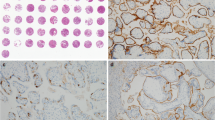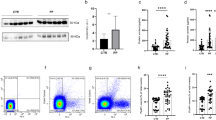Abstract:
Background
Fetomaternal hemorrhage (FMH) poses an immediate risk to the fetus and, in case of Rhesus-immunization, to future pregnancies. Given that altered endothelial permeability is part of the pathophysiology of inflammation, in this study we investigated whether placental inflammatory processes like chorioamnionitis (ChoA) or preeclampsia (PE) lead to increased rates of FMH compared to the established risk factor of placenta previa (PP). Putative accompanying markers of trophoblastic damage were also explored.
Methods
40 patients (14 PE; 6 ChoA; 9 PP; 11 normal controls) were evaluated for FMH using a flowcytometric test kit, which is able to quantify FMH of 0.06% fetal cells. Placental tissue samples were immunostained for human placental lactogen (hPL), human chorionic gonadotropin (hCG), and mucin-1 (MUC1). MUC1 was evaluated as a potential serum marker of FMH.
Results
Patients with ChoA had a mean calculated FMH volume of 29 ml, compared to 4 ml in PE and 1 ml in PP and controls. MUC1 staining was reduced in PE and ChoA placenta samples, while elevated MUC1 serum concentration correlated positively with FMH.
Conclusion
Diseases of placental inflammation are associated with FMH. Placental MUC1 staining is reduced and serum concentrations are increased in cases of FMH.




Similar content being viewed by others
References
Rubod C, Deruelle P, Le Goueff F, Tunez V, Fournier M, Subtil D (2007) Long-term prognosis for infants after massive fetomaternal hemorrhage. Obstet Gynecol 110(2 Pt 1):256–260
Sebring ES, Polesky HF (1990) Fetomaternal hemorrhage: incidence, risk factors, time of occurrence, and clinical effects. Transfusion 30(4):344–357
American College of Obstetricians and Gynecologists (1999) Prevention of Rh D alloimmunization. The College practice bulletin No.:4. Int J Gynaecol Obstet 66(1):63–70
Ness PM, Baldwin ML, Niebyl JR (1987) Clinical high-risk designation does not predict excess fetal-maternal hemorrhage. Am J Obstet Gynecol 156(1):154–158
Brandt CA, Ryom C, Grove A (1989) Chorioangioma placentae and feto-maternal transfusion; a report of two cases. Eur J Obstet Gynecol Reprod Biol 33(1):95–98
Suh YK (1999) Placental pathology casebook choriocarcinoma in situ of placenta associated with transplacental hemorrhage. J Perinatol 19(2):153–154
Redman CW, Sargent IL (2010) Immunology of pre-eclampsia. Am J Reprod Immunol 63(6):534–543
Newhouse SM, Davidge ST, Winkler-Lowen B, Demianczuk N, Guilbert LJ (2007) In vitro differentiation of villous trophoblasts from pregnancies complicated by intrauterine growth restriction with and without pre-eclampsia. Placenta 28(10):999–1003
Handschuh K, Guibourdenche J, Tsatsaris V, Guesnon M, Laurendeau I, Evain-Brion D, Fournier T (2007) Human chorionic gonadotropin produced by the invasive trophoblast but not the villous trophoblast promotes cell invasion and is down-regulated by peroxisome proliferator-activated receptor-gamma. Endocrinology 148(10):5011–5019
Toth B, Hornung D, Scholz C, Djalali S, Friese K, Jeschke U (2007) Peroxisome proliferator-activated receptors: new players in the field of reproduction. Am J Reprod Immunol 58(3):289–310
Jeschke U, Richter DU, Hammer A, Briese V, Friese K, Karsten U (2002) Expression of the Thomsen-Friedenreich antigen and of its putative carrier protein mucin 1 in the human placenta and in trophoblast cells in vitro. Histochem Cell Biol 117(3):219–226
Apostolopoulos V, Pietersz GA, McKenzie IF (1999) MUC1 and breast cancer. Curr Opin Mol Ther 1(1):98–103
Singh P, Hollingsworth M (2006) Cell surface-associated mucins in signal transduction. Trends Cell Biol 16(9):467–476
Shyu MK, Lin MC, Liu CH, Fu YR, Shih JC, Lee CN, Chen HY, Huang J, Huang MC, Hsieh FJ (2008) MUC1 expression is increased during human placental development and suppresses trophoblast-like cell invasion in vitro. Biol Reprod 79(2):233–239
Mayhew TM (2008) Taking tissue samples from placenta: illustration of principles and strategies. Placenta 29(1):1–14
Newton ER (1993) Chorioamnionitis and intraamniotic infection. Clin Obstet Gynecol 36(4):795
Scholz C, Kachler A, Hermann C, Toth B, Kainer F, Friese K, Jeschke U (2009) Flowcytometric assessment of fetomaternal hemorrhage during external cephalic version at term. J Perinat Med 37(4):334–337
Leers MP, Pelikan HM, Salemans TH, Giordano PC, Scharnhorst V (2007) Discriminating fetomaternal hemorrhage from maternal HbF-containing erythrocytes by dual-parameter flow cytometry. Eur J Obstet Gynecol Reprod Biol 134(1):127–129
Porra V, Bernaud J, Gueret P, Bricca P, Rigal D, Follea G, Blanchard D (2007) Identification and quantification of fetal red blood cells in maternal blood by a dual-color flow cytometric method: evaluation of the Fetal Cell Count kit. Transfusion 47(7):1281–1289
Cunningham FG, Leveno KJ, Bloom SL, Hauth JC, Gilstrap LC, Wenstrom KD (2005) Williams obstetrics., 22nd ed edn. McGraw-Hill, New York
Remmele W, Hildebrand U, Hienz HA, Klein PJ, Vierbuchen M, Behnken LJ, Heicke B, Scheidt E (1986) Comparative histological, histochemical, immunohistochemical and biochemical studies on oestrogen receptors, lectin receptors, and Barr bodies in human breast cancer. Virchows Arch Pathol Anat Histopathol 409(2):127–147
Pelikan DM, Scherjon SA, Mesker WE, de Groot-Swings GM, Brouwer-Mandema GG, Tanke HJ, Kanhai HH (2004) Quantification of fetomaternal hemorrhage: a comparative study of the manual and automated microscopic Kleihauer–Betke tests and flow cytometry in clinical samples. Am J Obstet Gynecol 191(2):551–557
Ochsenbein-Imhof N, Ochsenbein AF, Seifert B, Huch A, Huch R, Zimmermann R (2002) Quantification of fetomaternal hemorrhage by fluorescence microscopy is equivalent to flow cytometry. Transfusion 42(7):947–953
Fernandes BJ, von Dadelszen P, Fazal I, Bansil N, Ryan G (2007) Flow cytometric assessment of feto-maternal hemorrhage; a comparison with Betke–Kleihauer. Prenat Diagn 27(7):641–643
Kush ML, Muench MV, Harman CR, Baschat AA (2005) Persistent fetal hemoglobin in maternal circulation complicating the diagnosis of fetomaternal hemorrhage. Obstet Gynecol 105(4):872–874
Dziegiel MH, Koldkjaer O, Berkowicz A (2005) Massive antenatal fetomaternal hemorrhage: evidence for long-term survival of fetal red blood cells. Transfusion 45(4):539–544
Jansen MW, Korver-Hakkennes K, van Leenen D, Visser W, in‘t Veld PA, de Groot CJ, Wladimiroff JW (2001) Significantly higher number of fetal cells in the maternal circulation of women with pre-eclampsia. Prenat Diagn 21(12):1022–1026
Holzgreve W, Ghezzi F, Di Naro E, Ganshirt D, Maymon E, Hahn S (1998) Disturbed feto-maternal cell traffic in preeclampsia. Obstet Gynecol 91(5 Pt 1):669–672
Lapaire O, Holzgreve W, Oosterwijk JC, Brinkhaus R, Bianchi DW (2007) Georg Schmorl on trophoblasts in the maternal circulation. Placenta 28(1):1–5
Hsu CD, Smith K, Hong SF, Johnson TR, Gollin Y, Chan DW (1995) Does preeclamptic pregnancy increase fetal-maternal hemorrhage? Am J Perinatol 12(3):205–207
Dharmaraj N, Wang P, Carson DD (2010) Cytokine and progesterone receptor interplay in the regulation of MUC1 gene expression. Mol Endocrinol 24(12):2253–2266
Hanisch F, Schwientek T, Von Bergwelt-Baildon M, Schultze J, Finn O (2003) O-Linked glycans control glycoprotein processing by antigen-presenting cells: a biochemical approach to the molecular aspects of MUC1 processing by dendritic cells. Eur J Immunol 33(12):3242–3254
Ueno K, Koga T, Kato K, Golenbock D, Gendler SJ, Kai H, Kim KC (2008) MUC1 mucin is a negative regulator of toll-like receptor signaling. Am J Respir Cell Mol Biol 38(3):263–268
Koga K, Mor G (2008) Expression and function of toll-like receptors at the maternal-fetal interface. Reprod Sci 15(3):231–242
Scholz C, Toth B, Santoso L, Kuhn C, Franz M, Mayr D, Jeschke U, Friese K, Schiessl B (2008) Distribution and maturity of dendritic cells in diseases of insufficient placentation. Am J Reprod Immunol 60(3):238–245
Acknowledgments
The authors are very grateful to Prof. S. Endres and his team at the Division of Clinical Pharmacology, University of Munich for their generous assistance with flow-cytometric experiments.
Conflict of interest
None.
Author information
Authors and Affiliations
Corresponding author
Rights and permissions
About this article
Cite this article
Scholz, C., Hermann, C., Kachler, A. et al. Association of placental inflammation with fetomaternal hemorrhage and loss of placental mucin-1. Arch Gynecol Obstet 285, 605–612 (2012). https://doi.org/10.1007/s00404-011-2028-1
Received:
Accepted:
Published:
Issue Date:
DOI: https://doi.org/10.1007/s00404-011-2028-1




